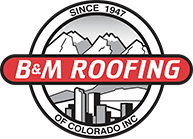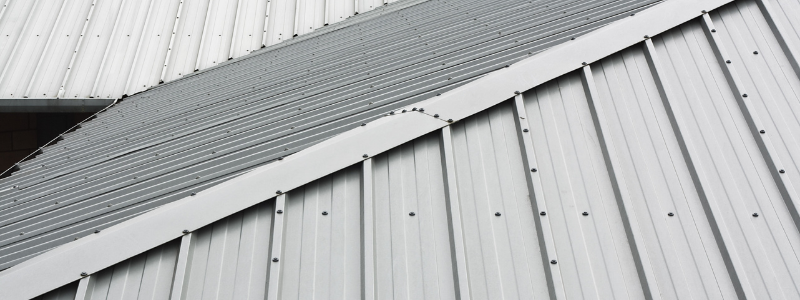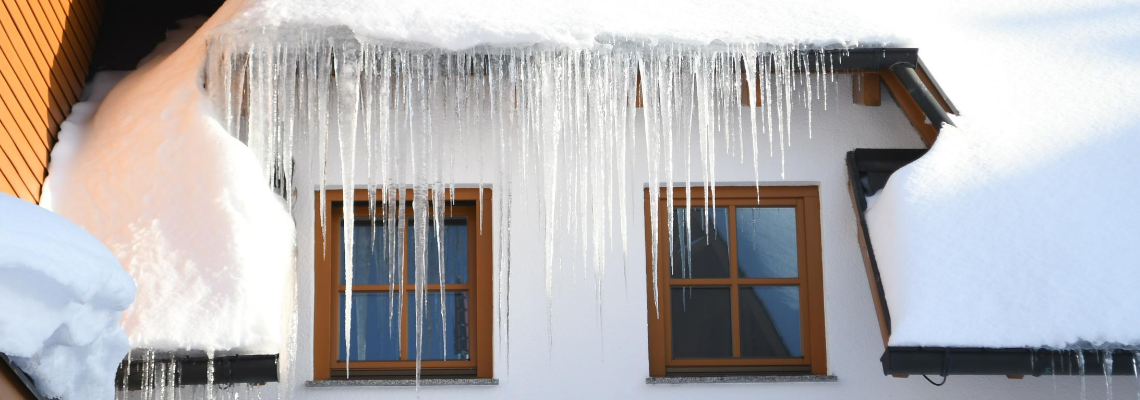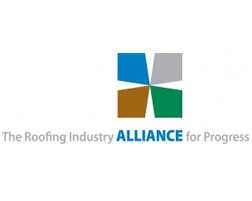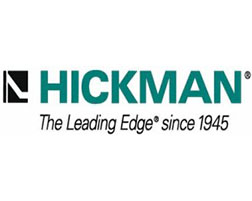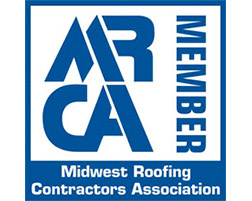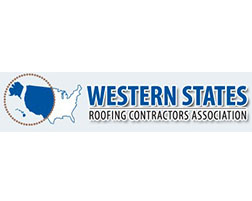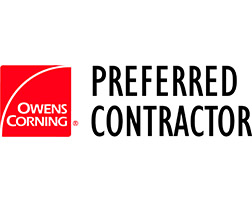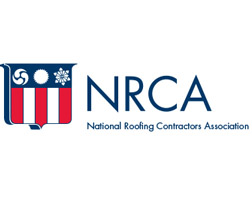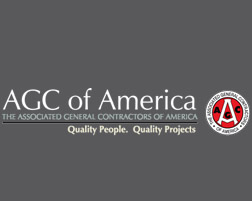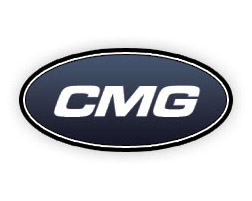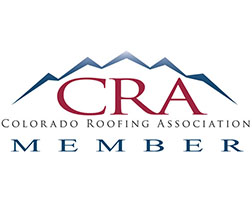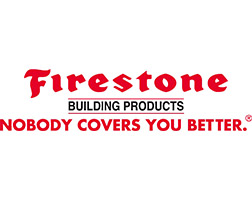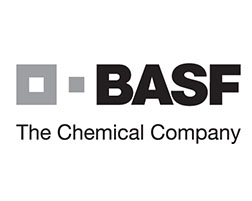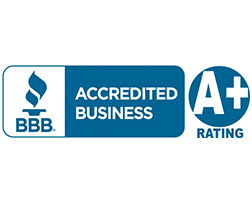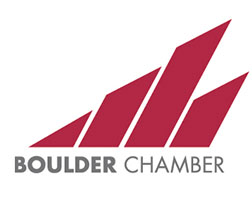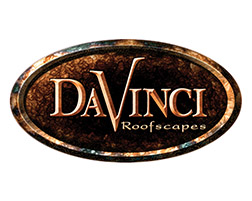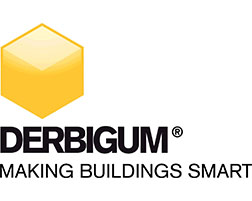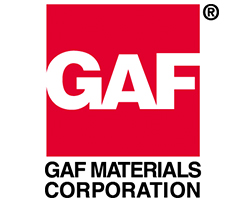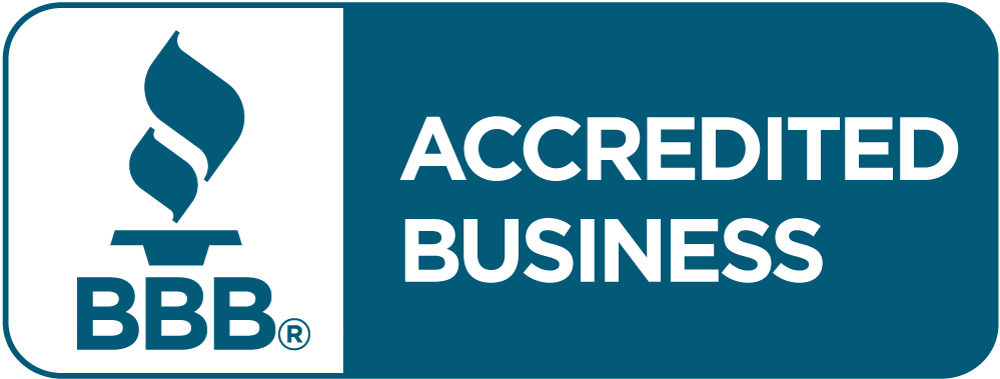Metal Roof Fading
If you have a metal roof or are considering getting one, you should be prepared for it to fade and chalk over time. However, this is just one thing to be aware of when deciding whether to use a metal roof or not. This article will take you through some of the benefits of using metal roofs, what metal roof chalking and fading actually is as well as how to prevent it, and what the best colors may be for a metal roof.
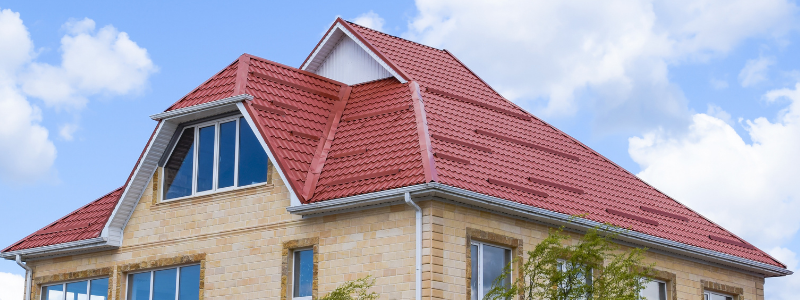
Why Use Metal Roofing?
There are many reasons why somebody might choose to go with a metal roof.
They are extremely durable and long-lasting, especially when compared to other traditional roof materials such as asphalt.
You also have the ability to customize the color of your metal roof’s paint, as they can be painted black, red, green, pink, or anything you’d want. In comparison, most asphalt roofs are very limited in their color options.
In addition, metal roofs are also very energy efficient: A basic, unpainted metal roof is estimated to save a traditional home up to 40% in energy costs. Metal roofs reflect sunlight, and therefore, can help keep buildings cool in the summer without the excessive use of air conditioning. They also provide excellent insulation in the winter.
Sustainability is another reason why people may choose to use metal roofing. Since metal is an easily recyclable material, many metal roofs these days are sourced from recycled metal. Additionally, since metal is an extremely durable material, you will need to replace it less often than you would with other roof materials, thereby reducing the total waste your home or business produces.
Lastly, you may want to use metal roofing simply because it looks cool! Metal can give a home or office a sleek, unique look that will set it apart from other buildings in the area.
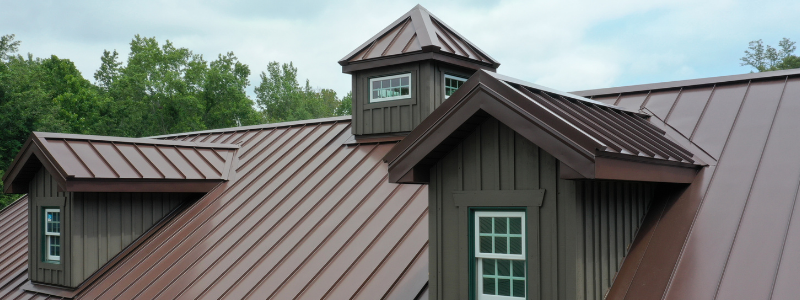
How Long do Metal Roofs Last?
With proper care, metal roofs are expected to last anywhere from 40 to 70 years.
In comparison, asphalt normally only lasts between 12 and 20 years, and wood shingles will last, at an absolute maximum, about 45 years.
Metal roofs are the most durable and long-lasting roof materials currently being used today.
Because metal roofs are so long-lasting, they will be significantly cheaper in the long run. Currently, metal roofs cost about twice as much as asphalt roofs, however, when you factor in that metal roofs will last up to 5x as long as asphalt, it’s clear that they give you much a better bang for your buck.
Metal roofs will often last longer, especially with proper maintenance. If you believe your roof is in need of service or repair, the roofing experts at B&M Roofing will happily come to give you a free estimate.
What is Metal Roof Fading?
Over time, environmental elements such as sun, rain, snow, and pollution will interact with and deteriorate a metal roof’s paint pigments.
A common misconception people have is that metal roof fading is causing damage to the roof, which is not true.
Metal roof fading is a natural process, as overtime, any paint color will fade with exposure to harsh elements.
However, although fading in and of itself isn’t damage to a roof, if it is not addressed, this can shorten your roof’s lifespan.
Paint protects the actual metal, and when the paint is worn down, the metal roof itself will wear down faster. This is one reason why you will want to make sure you are using high-quality paint for your metal roof.
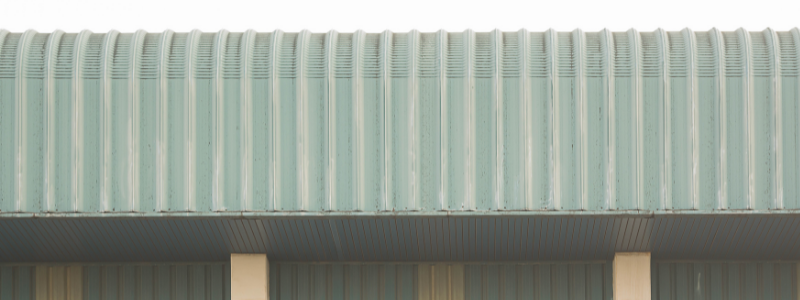
What is Metal Roof Chalking?
Metal roof chalking is the formation of whitish residue on painted or coated metal.
Unfortunately, this whitish residue is not actually true chalk- if it were, you’d definitely see a lot more roof repair companies dabbling in producing sidewalk chalk.
Metal roof chalking occurs through a similar process as metal roof fading.
As the paint or resin on your metal roof wears down, it will turn white and chalky, hence the name.
Once again, metal roof chalking isn’t indicative of damage being done to the roof.
But, since paint and resin are protecting the actual metal, unaddressed chalking can shorten a metal roof’s lifespan.
What Colors are Best for Metal Roofs?
The most important thing when selecting what color to paint your metal roof is to ensure that a high-quality metal paint is used.
If you’re overly concerned about chalking and fading, lighter, inorganic paint colors will chalk and fade slower, plus it will be less apparent when they do.
For example, it will be really difficult to see a light grey fade when compared to vibrant red color. Additionally, different paint colors can have different benefits- for example, a lighter roof will reflect more heat than a roof painted black, and therefore keep your home cooler in the summer.
Ultimately, chalking and fading are just one factor you should consider when making a decision about what color to paint your metal roof.
If you really strongly want a darker, or more uniquely colored roof, choose that color, and just make sure that you’re using high-quality paint.
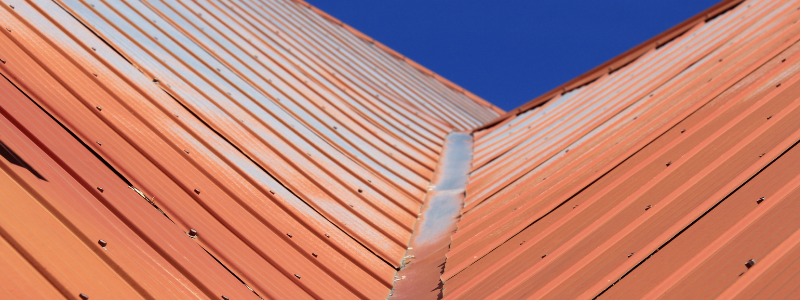
How to Prevent Metal Roof Chalking and Fading
Chalking and fading is a natural process, but there are specific steps that you can take to delay and mitigate their effects.
Lighter, inorganic paint colors will chalk and fade slower, and it will be less apparent when they do. In addition, choosing high-quality metal paints can, and will make a gigantic difference when it comes to protecting your roof.
You can also do the best you can to avoid exposure to certain elements, such as sunlight, moisture, and pollution. For example, roofs that face north are exposed to significantly less direct sunlight than roofs that face south.
However, roofs are obviously meant to provide you with protection from elements!
Finally, a great step to take is to purchase a roof warranty and ensure that the warranty you purchase covers chalking and fading.
Roof chalking and fading is a natural process that will happen over time, but a proper warranty will address chalking and fading. This will help protect your metal roof’s lifespan while keeping your roof looking the way it’s supposed to.
If you’re interested in installing a new roof for your home or business, look no further than B&M Roofing.
We are true experts in roofs, having skillfully provided reliable roof coverings since 1947. We can give you a free estimate, & will work with you every step of the way, from determining which roof (metal or not) is best for you, installing your new roof, and providing regular maintenance.
Spring Roofing
Spring is in the air and that means … making sure your roof made it through the winter without damage.
The winter and harsh weather of Colorado can really wear down your roof, whether it’s a typical asphalt shingles roof, metal roof, or any other type of roof. Snow can cause damage like ice dams and wind can ruin shingles and cause debris. The combination of sun and cold, dry weather can also wreak havoc on your roof.
So, when springtime comes around, it’s the perfect time to get a roof repaired, replaced, or at least, if nothing else, inspected. Better weather means better conditions to work on your roof, so spring roofing is primetime roofing.
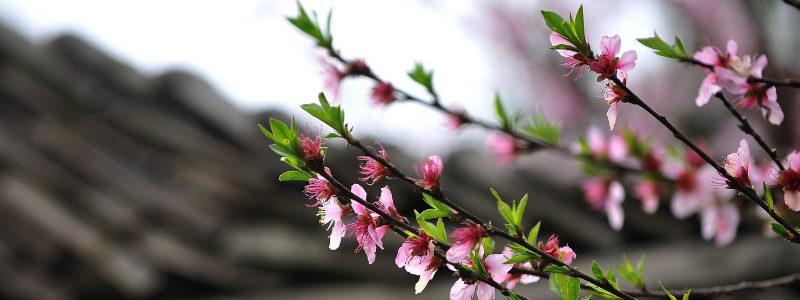
Spring Roof Repair and Replacement
Spring is a season of turning over a new leaf – a time of renewal, rebirth, and renaissance. It’s also a popular time for renovations, repairs, reorganizing, and much more spring cleaning activities. Spring roofing means repairing and replacing roofs that took damage from winter, age, or a little of everything.
Spring is a great time to get quality work done on your roof, no matter the amount of work your roof requires. It’s also a time where you find a lot of roofers that just aren’t qualified. We urge you to find reputable Colorado roofing contractors to make sure the job gets done right.
Roofs we specialize in:
- Slate
- Clay
- Metal
- Wood
- Shake
- Composition
- Shingle
We even repair and replace flat roofs on residential properties within the Front Range area.
Colorado has a reputation for frequent thunderstorms and bad weather. Spring roofing also means repairs from hail and storm damage.
Every year dozens of powerful storms roll through Denver and the Front Range and cause damage to residential as well as commercial properties.
Repair and replace your roof if needed to prevent any future damage.
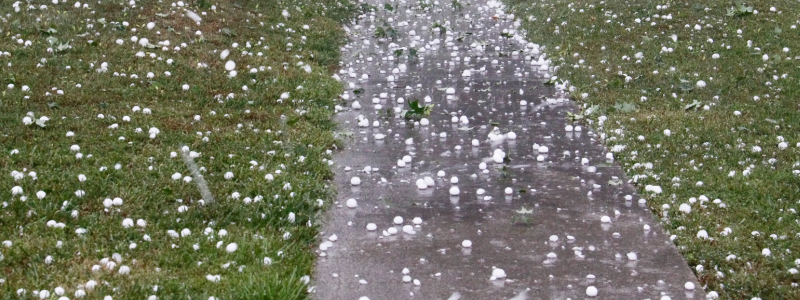
Spring Hail & Storm Damage
Hail is no stranger to Colorado and B&M Roofing contractors are helping residents recover from the hail damage to their roof. Hail storms and high winds can cause damage to roofs that need to be repaired quickly in order to avoid further damage to your property.
When a hail storm rolls through town, it’s followed by a flurry of fly-by-night roofing contractors looking to take advantage of victims of storm damage in their time of need. These contractors don’t have established roots in Denver, or anywhere in Colorado for that matter, and will leave homeowners and property owners stuck with a low-standard roofing job and little-to-no warranty.
When you need roof repair due to storm damage, make sure you get a quality Colorado roofing company that understands your community. B&M Roofing is highly qualified to help you get your roof repair or roof replacement is taken care of promptly and professionally.
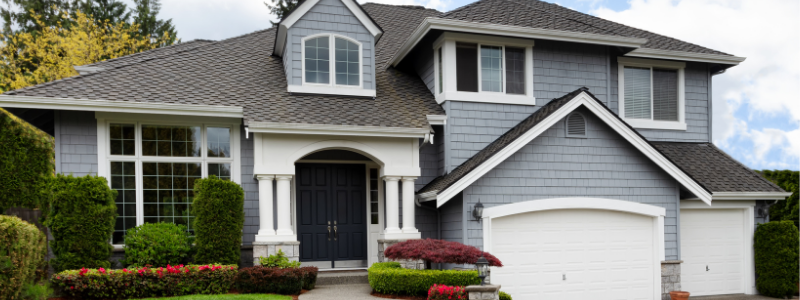
We Work with Your Insurance
We have a great reputation not only with property owners but with insurance representatives too.
We understand the insurance claims process.
We make sure you get everything your insurance entitles you to, after a damaging storm.
When storms hit the Denver area, insurance companies are busy writing checks to property owners to make sure the damage is taken care of and further damage is avoided. The good news is most property insurance policies cover roof damage due to storms and inclement weather.
The sooner you can find issues with your roof that need fixing, the quicker and less expensive they will be. It usually starts with an inspection. You can save time and money by assessing your roof for damage and call a professional roofer after inspection.
While we don’t promote homeowners and business owners getting up on their roof, there are safe ways to do so, to inspect your property’s roof.
If you are comfortable enough with doing a quick roof inspection, you can use B&M Roofing of Colorado’s spring roof inspection checklist to walk you through your warm-weather inspection.
Spring Roofing Inspection Checklist
Before you climb on the roof, however, ensure you do it safely. Place your ladder on a firm, level surface, at the angle specified by the manufacturer. Secure it to your roof, but not in a way that presents a tripping hazard. For more tips on ladder safety, visit our Ladder Safety blog.
- Gutters: Clear the rain gutters of any material that may have collected in them over the winter. Clear all debris by hand before flushing them to prevent clogs in downspouts.
- Downspouts: Use a hose to flush downspouts and loosen any material that may have become lodged in them throughout the winter. With the hose in the downspout, inspect each one to ensure it’s free of leakage that can cause water to collect around your foundation.
- Roofing Materials: Inspect your shingles or tiles for visible damage, such as cracks, tears, or missing chunks. Pay special attention to pipes and other protrusions from the roof where snow and ice may have accumulated and damaged the seal.
- Vents: Vents in your rooftop, under your eaves, or in the rafters are essential to keeping air flowing through your home. Make sure they’re unimpeded and allow air to circulate.
- Chimney: While you’re on the roof, take the opportunity to check that your chimney is still in good health. Check that masonry is intact and that white stains, similar to calcium buildup, aren’t building up, which can indicate your chimney is absorbing water.
Think you need repair or want a professional opinion about your roof’s health?
Call us at 303.443.5843 or on our Estimate Request Form to request a visit from B&M Roofing’s professional estimators.
Signs of a Bad Roofing Job
Usually, the decision to replace a roof is prompted by wearing, damaged, or missing shingles. A new roof or reroofing is necessary to prevent leaks. Leaks can result in the build-up of mold in the building. Water leaking into the interior can also rot the structure of your home or commercial building.
Roof damage will almost certainly result in serious interior structural damage. If left untended, repair costs mount at alarming rates.
If your roof is in good shape, it adds significantly to the property value and curb appeal of your building. However, there are some instances where, even with a roof replacement, there are issues with a roof. Some issues can arise because of a bad roofing job. Know the signs of a bad roofing job and how it can be fixed, once and for all.
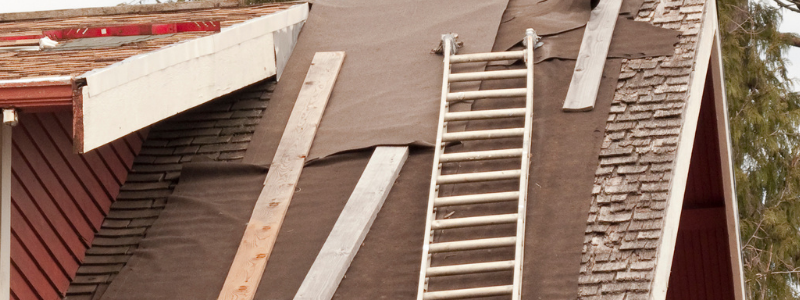
When is the Best Time for Reroofing?
Clear skies and some sun are ideal conditions for reroofing. That’s why spring is a very good time to get that roof repaired.
Spring is also a time when many building owners notice roof problems. Winter brings harsh conditions including cold, ice, and snow. When the snow and ice begin to melt, it is not surprising to find leaks. When temperatures begin to rise adhesive on asphalt shingles will be more effective. The conditions are ideal. With heat increases in the summer, reroofing conditions are more challenging. Autumn can bring wind and rain conditions that make roofing projects challenging.
Beware of Imposter Roofing Companies
Spring is a time when many building owners want roof repairs. Unfortunately, unscrupulous roofers take advantage of the demand. There are scammers out there ready to take your money. Guard against poor roofing repairs by taking these steps:
- Ask people you trust about their recommendations for a reputable roofing contractor.
- Ask questions about whether the company has insurance for injury and property damage. Is the company bonded, and licensed?
- Demand an estimate. If the deal sounds too good to be true, it probably is.
- Ask to see examples of work they have completed. Ask to talk to previous customers.
- Check out the company with Better Business Bureau in your area.
- What does social media reveal about this company?
- If they ask for money upfront, alarm bells should go off in your head.
- Don’t sign a contract until you have details and guarantees in writing.
- Look for a local company that has been in the business for several years.
- Don’t sign off on a job until you have inspected the work.
- Don’t pay until all aspects of the job have been fulfilled to your satisfaction.
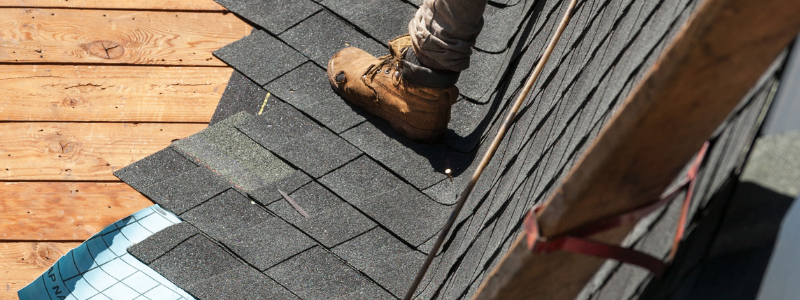
Signs of a Bad Roofing Job
Stand on the ground and look up at the reroofing project. Do all sections of the roof look uniform?
Does your visual inspection note parts of the roof that are aging differently?
Can you see cracked or missing shingles? Is the roof is missing shingles or does it have damaged shingles?
Are there stains that indicate leakage?
Check out the shingles. Are they mismatched? This indicates the roofer ran out of shingles and substituted a different color, or failed to replace some. Reputable roofers order the right amount of materials and do not skimp.
Examine roof decking, underlay, drip edges, and flashing. Are these in need of repair or replacement? Is the flashing new? Has it been properly installed and caulked? Inexperienced or shoddy roofing contractors often reuse flashing materials from other jobs to save money. Are there signs of rusty flashings or vent pipes?
Is the roofline sagging? The roofline should be straight. If there are dips or curves, the roof decking should have been replaced.
Send a knowledgeable person up on the roof. Different roofs require different nails. Were the correct nails used? Are they properly spaced so the shingles won’t be dislodged or leak? An expert will be able to point out other signs of a bad roofing job and what to do about it.
How Can You Tell if You’re Getting a Good Deal?
- Did the roofing company estimate competitively?
- Was the contract detailed and specific? Did the company fulfill all aspects of the contract?
- Was the job finished on time and within the estimated cost?
- Did the company leave the area the way they found it? Were shrubs and flower beds left intact? Reputable roofing contractors clear all construction debris, packages, and old shingles. Did you have to dispose of these materials yourself?
- Upon visual inspection, does the roof look uniform? Are the shingles all the same color? Is the roofline straight with no sags?
- Did the roofer begin with a starter shingle and continue upward creating both a uniform appearance and allowing shingles to work effectively?
- Did the job include metal drip edge flashing? Drip edge flashing carries water away from your building. They ensure the gutters do their job. This prevents water damage and guards against pests, rodents, and insects entering the attic. Look at the eaves and gable. A metal flashing fits between the shingle and the underlayment. Did the roofing company custom fit drip edge flashings to create a more secure border on your roof?
- Were roof vents replaced with new ones?
- When the roof was being installed, did the job include underlayment? Quality roofers place an underlayment between the sheathing and the shingles. This acts as an additional barrier to protect from moisture or water leaks.
- Did the roofing specialists install rodent covers to prevent rodent damage and debris from getting into plumbing pipes?

Why You Should Choose B&M Roofing to Replace Your Roof
B&M Roofing has been providing satisfied Colorado customers with quality roofing since 1947. We are a local company with strong ties to their Denver-area community.
When Colorado’s challenging weather conditions have damaged your roof, it is important to select a Colorado roofing company that understands Colorado roofing issues. Our licensed, bonded, and insured roofing experts will restore your roof, the gutters, downspouts, windows, doors, and siding to their original condition.
When you are looking for an experienced, competent roofing specialist, your best guarantee of good service is customer satisfaction. Ask trusted friends, relatives, co-workers, and neighbors about our roofing projects. Check out the testimonials on B&M Roofing’s website. Happy clients will tell you that we provide competitive estimates and prompt, professional work.
Our roofing specialists offer prompt, professional work. We leave your property neat and free of debris and finish on time. We use only quality materials that will produce a structurally sound, aesthetically pleasing roof.
B&M Roofing can provide informed, experienced suggestions to help clients make informed decisions about reroofing. We’ll be honest about looking for signs of a bad roofing job. Trust us –
To discuss your roofing needs or to book a free roof inspection and reroofing estimate, call 303-443-5843 or get a free estimate here.
Things to Consider When Replacing a Roof
Replacing a roof on any home is a large job, which is why we dedicate entire teams to it. We understand that you want life around your home to be back to normal as quickly as possible. While it should only take a few days to complete your project, depending upon its size and the weather, you’ll want to prepare your home for the job. On top of prep work, there are just some things to consider when replacing your roof. From the style and materials to budget and tear-off, here are some things to consider when replacing a roof:
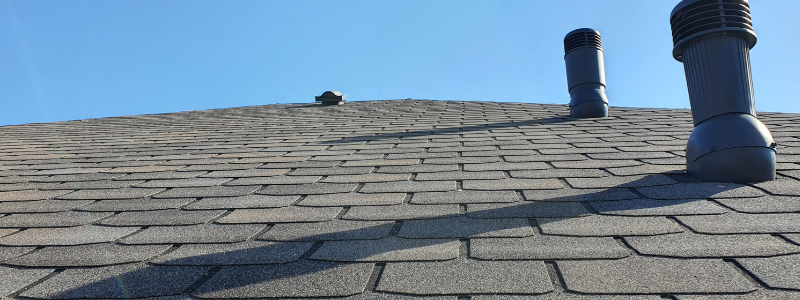
Consider These Things When Replacing a Roof
A lot of things are probably going through your head when you’re needing to replace your roof. Let B&M take care of the hassle and headache.
Preparation
Roof replacement is easier than you think and the better you’re prepared, the smoother the process will go.
Secure Loose Items
Our teams will be on your roof, hammering, moving piles of materials, and generally working quickly. This is likely to cause vibrations in your home. The extent of these disturbances varies by how your home is constructed, and they are often barely noticeable. However, preserve breakables such as hung pictures, mirrors, and fragile items on shelves by removing them to a place where vibrations won’t knock them over.
Clear Your Driveway
Typically, our teams park their vehicle in your driveway during the project. That gives us the fastest and most effective place to load shingles and if you need old roofing removed, to collect discarded materials. Having a driveway free of cars and other clutter helps us get your project done quickly.
Prepare Your Yard
Our teams take great care to prevent any damage to landscaping or other property during our roofing projects. Items such as nails and old roofing inevitably fall during construction. Remove any items such as barbecues, boats, patio furniture, and statuary that may be damaged by falling material.
Mind Children and Pets
Your home will be an active construction site as our teams work to put your new roof on. It’s no place for children or pets to be around. Protect your loved ones by keeping them inside during the project.
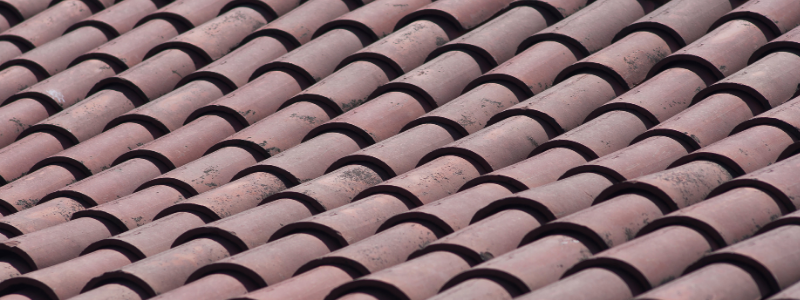
Style of Roof
If you haven’t already decided on what type of look you’re wanting, think about the style of roof that fits your budget, as well as the style and functionality of your home. Are you looking to fit in with the other houses in your neighborhood or do you want to stand out? What about the type of roof material? Our expert roofers at B&M Roofing can help walk you through different types of roofs that are common in Colorado and help you choose a style.
Roofing Materials
We briefly touched on this, but there are a few different options as far as roofing materials. While asphalt shingles are the most popular with residential properties in Colorado, there are a few other materials to choose from. Synthetic options last the longest in this harsh weather, but there are a lot of options to choose from. We work with only the finest manufacturers, like GAF, Owens Corning, CertainTeed, and much more. We’ll give you our best recommendations for which material is cost-efficient, energy-efficient, and practical.
Budget
When determining a budget, consider how long you’ll live in your house, how long you want your roof to last, the weather (hail, snow, etc), and which materials are most cost-efficient. When you think long-term, you’ll save more money in the long run. Metal roofs and synthetic materials tend to last the longest while clay roofs may look nice, but don’t last long (especially in Colorado’s harsh weather).
Types of Warranties
Each type of roofing material (slate, asphalt shingles, wood shake, metal, etc.) comes with a warranty. Most standard roofs come with a 20-year warranty while some others (composite and synthetic material) come with a 40 or 50-year warranty. No matter which type of roof you’re leaning towards, we’ll always make sure to include the warranty for each option, to help you decide which roof is best for your home.
HOA
If you’re part of a homeowner’s association, there may be certain limitations, restrictions, or guidelines for your neighborhood. Make sure to include your HOA in all roofing decisions you’re about to make and keep them in-the-loop with what you’re considering. Chances are you’re going to need the approval of your HOA when replacing your roof. This may not be your exact neighborhood, but we’ve included an example of some HOA roofing guidelines to follow here.
Roof Overlay vs Tear-Off
Depending on your budget, you may also be considering whether you’d like us to lay a new roof over your existing one or tear everything off and re-roof it all together. Depending on the state of your existing roof, we’ll make our best recommendations, but usually, roofing codes only allow no more than two layers of shingles on your roof.
Don’t Forget the Gutters
It may not be something that’s top-of-mind when you think about replacing your roof, but the gutters require constant upkeep and maintenance. We’d recommend using some type of gutter guard, or gutter cover, from a reliable source. We’ll be sure to make our own recommendations from roofing manufacturers with whom we work, but you have a variety of options.
If you’re ready to get started on your roofing project, contact the experts at B&M Roofing!
Interior Signs of Roof Damage
In spite of homeowners’ best intentions, roof damage occurs. Risk factors include Colorado’s cold winter temperatures, snow, heavy rainfall, and heat. Besides the weather, roof damage can occur because of poor roofing materials, inferior installation. Lack of regular inspection and upkeep can accelerate roof damage. The best way for homeowners to assess roof damage is by inspecting the roof itself. However, there are many interior signs of roof damage. These may prove more costly than the price of roof repair or replacement. Roof damage is not always easy to spot. If your roof style doesn’t allow you to get up there safely and easily, then you may miss signs that your roof needs immediate repair. Most homeowners don’t own the necessary equipment and safety harness to do an annual roof inspection themselves. That’s why it is important to have a roof inspection specialist assess the condition of your roof at least once a year. From inside your home, you can look for interior signs of roof damage.
How to Check for Interior Signs of Roof Damage
Ask yourself these key questions:
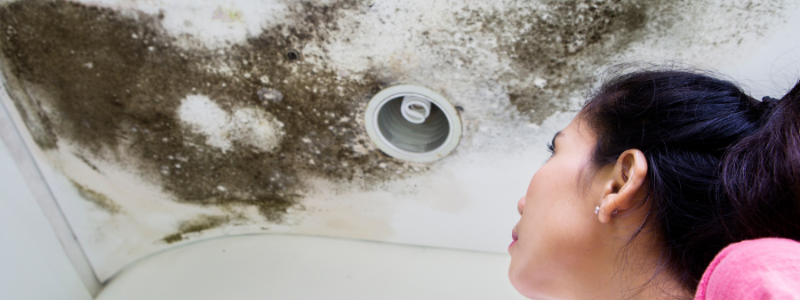
Is there Mold Growing in Your Home?
When moisture accumulates in your home, there is a greater risk of mold spores growing.
Mold is nothing to take lightly. Over a hundred thousand species of mold can grow in your house if the water is allowed to accumulate.
How can you spot mold growth? Be on the lookout for musty spells. Look for mold growth on surfaces.
Sabrina Felson warns of the dangers of exposure to mold. Early signs that you may have mold exposure include things like headaches, sneezing, itchy skin, rashes, or irritated eyes.
If mold is not eliminated, you could develop more serious health conditions like respiratory difficulties, ear infections, nausea, blurred vision, chronic fatigue, neurological disorders, or heart palpitations.
Among the methods of preventing mold from growing, the Centers for Disease Control and Prevention advocates keeping your roof in good repair and making sure there are no leaks around windows and pipes.
Is Paint Peeling on the Walls or Ceiling?
If the paint on your walls and/or ceiling has begun to blister or peel, it may be a sign of roof damage. When you notice peeling or blistered paint, the first step is to repair or replace the roof.
The next step is to fix the damaged areas. First, scrape off the peeling paint with a putty knife and sanded. Clean off the accumulated dust. Apply a thin layer of patching compound with a putty knife. Allow the treated area to dry. Do this twice before priming the area with an oil-based primer. When the primer is dry, paint the repaired area with flat acrylic paint.
Are Puddles of Water Accumulating on the Floor?
If your roof leaks, you may begin to notice water puddles when it rains. Although buckets to catch those drips provide a temporary fix, you need to repair or replace that roof soon. Otherwise, those puddles will ruin the flooring.
Water puddles present a risk to the health and safety of home residents. Slip and fall injuries are more likely on wet floors.
There are more dangers of standing water in your home. Even if the water is clean, it can be a breeding ground for mold. Parasites, bacteria, and mold spores can develop in as little as two days as noted by a Flood Services study.
Can You See Light Coming through the Attic?
While you can’t always perform a visual study of the exterior of your roof, you can check out the attic.
If you can see light in a darkened attic during a sunny day, there are holes or cracks in the roof. These open spaces will let in rainwater.
In no time, mold and deterioration of insulation will occur. This accumulating moisture will also break down roof materials.
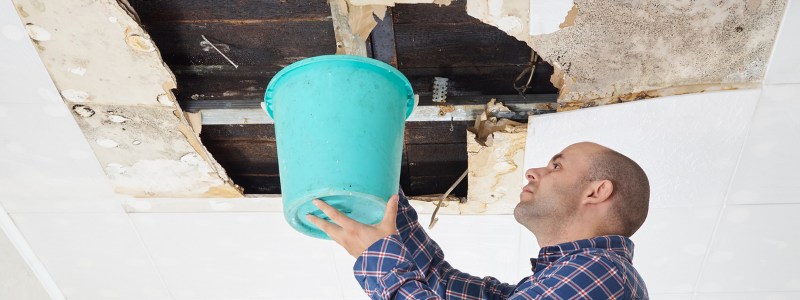
Are Moisture Levels on the Rise?
When a roof is damaged, there are gaps or cracks between the roofing materials. The result is an accumulation of moisture or an increase in humidity.
Rain can seep into your home not just through damage to the roof. Rainwater can also enter through the foundation because gutters don’t work properly to direct water away from the foundation.
When you have your roof inspected annually, make sure the roofing inspection includes gutter cleaning and repair.
If moisture droplets accumulate on floors, ceilings, and wall surfaces and run down into walls, windows, and structural components, they will create an optimum environment for bacteria, mold, and mildew. This can create rot and peeling paint. Furniture, drapes, and other household items will get damp and musty.
Is there Structural Damage to the Interior of the Roof?
Water that gets into your home from a leaky roof can create severe structural damage.
It is important to inspect exterior trim, wall framing, ceiling joists, rafters, and fascia boards for any signs of damage.
If water gets in repeatedly, the wooden components of your house will start to rot. This weakens them over time. The result may be roof failure.
Repairing the structural damage should be a part of roof repair or replacement. If the roof is not fixed, the root cause of structural damage to the interior of the roof will continue. You will soon be repairing that structural damage all over again.
Have Your Energy Bills Increased?
Roof damage isn’t the only reason for an increase in energy bills. Perhaps rates have gone up. Maybe your household has increased and appliances are being used more.
However, when energy bills increase without a logical explanation, chances are roof damage is the cause.
Roof damage can go undetected for a long time if your roof is not inspected regularly. If this is the case, your energy bills will continue to mount.
When the insulation under the roof is damaged or eroded, your heating/cooling system must work overtime to maintain comfortable temperatures in your home. This will increase your household’s energy consumption.
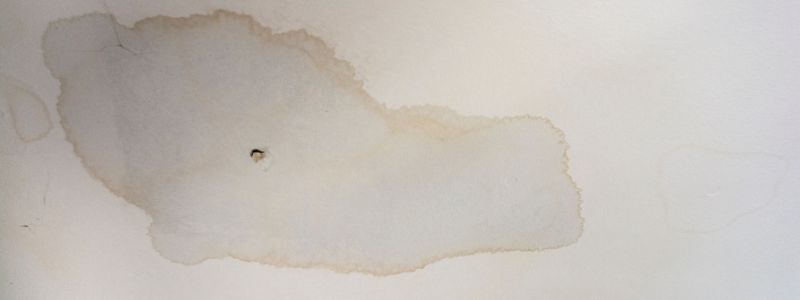
Has Your Ceiling Developed Unsightly Stains?
If water gets in through a damaged roof, it is likely to stain ceilings and other areas of your home. Water blemishes may be brown, grey, or even yellow. If you notice stains, it’s time to have your roof checked.
A roof inspection specialist will be able to pinpoint the problem and repair or replace the damaged roof.
How Can B&M Roofing Help?
B&M Roofing specializes in repairs and roofing of residential and commercial structures. Our technicians can ably handle such projects as roofing, remodeling, as well as cleaning and repairing eaves and gutters.
B&M Roofing has been a trusted roofing repair and replacement business in Colorado since 1947. Our knowledgeable, skilled roofing technicians can assess needed repairs. They are capable of using all roofing materials on any type of roof.
If you own a Colorado home, B&M Roofing is ready and eager to meet your roofing repairs and replacement needs.
For a free assessment of your roof, contact us at https://bmroofing.com/ or give us a call at (303) 443-5843.
Average Roof Replacement Costs
At B&M Roofing, we understand that roof replacements are not an everyday occurrence for homeowners. When they do happen, it’s often due to an aging or compromised roof that needs attention. This means that budgeting for a roof replacement is rarely a priority in the home improvement financial plan. So, how much should you expect to spend on an average roof replacement? Let us break it down for you.
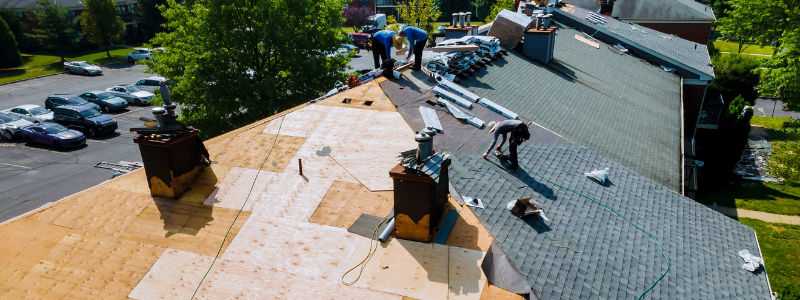
How Much Does the Average Roof Replacement Cost?
Want a quick answer? You’ll want to budget between $4,200 and $6,600 for replacing a 1,600-square-foot roof. This estimate assumes materials like asphalt roof shingles. If you use materials like metal, wood shingles, or clay tile, the cost could increase to between $9,500 and $16,000.
For a more accurate assessment of your roof, consider using a roofing replacement cost calculator app.
How are Roof Replacement Cost Estimates Determined?
When experienced roofing contractors arrive to provide a free estimate, they take into account several key factors. This is how they give an accurate cost analysis.
Roof Measurement
Roof measurements are taken digitally. Roofing contractors utilize technology such as satellite imagery and drones. Their calculations take into account factors such as the slope, roofline peaks, and the overall complexity of your roof.
Roof Inspection
In a thorough roof inspection, roofing contractors assess the condition of your roof. This helps them determine the project’s scope.
Roofing Materials
Experienced roofing contractors will explain the advantages of various materials and make recommendations concerning the best roofing system materials for your home or business. They will factor in such things as shingles, ventilation, roof accessories, and warranty.
Calculating Costs
Once the roofing contractor has obtained this information, the company is prepared to provide an accurate estimate of the question: How Much Does the Average Roof Replacement Cost?
The roof replacement specialists will factor in labor, materials, warranty, permits, the cost of removing old materials, and cleanup.

Key Factors in Roof Replacement Costs
Many variables factor into the answer to the question: How Much Does the Average Roof Replacement Cost?
Roof Size
Roofing specialists calculate the cost of roof replacement on a square footage basis. The roof area is one of the most significant factors to consider when determining the cost of an average roof replacement.
A U.S. Census figure notes that the average house roof in the United States is approximately 1,700 square feet.
Roofing Materials
The second most crucial factor to consider in the cost of roof replacement is the type of materials used. Asphalt shingles are both popular and economical. Metal roofs, wood, slate, clay, or solar tiles are more expensive. However, these materials often have other benefits. They may provide better curb appeal, extra insulation, or solar power for your home.
Roofing materials range in price from $100 to $1,000 per square foot. Experienced roofing contractors can help you determine the best roofing materials for your budget.
Roof Complexity
Steeper roofs require more staging and safety precautions. They usually take longer to install. Thus, labor costs will be higher.
The pitch is not the only consideration. Roofing contractors also factor in chimneys, skylights, and ventilation pipes. It takes extra time to work around these complexities.
The complexity of the roof design must also include various changes in the roofline. These can result in both extra labor and materials.
Location
The cost of roof replacement depends on your location. Fluctuations in cost may reflect regional differences in cost of living. Material and labor costs vary based on climate and other factors.
For example, the average roof replacement cost in Denver is slightly above average. A survey of roofing contractors in various parts of America revealed that prices range from $4,500 to $10,000 to replace a roof.
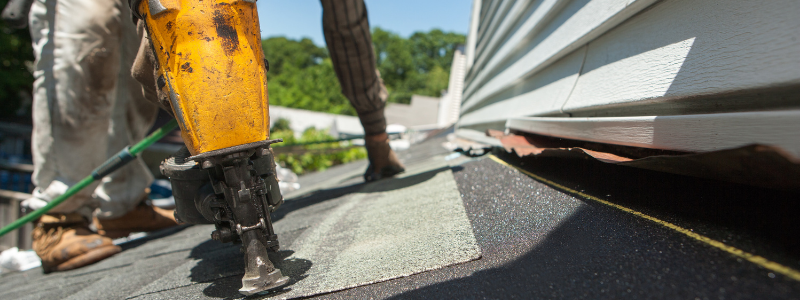
Why Replace Your Roof?
A new roof is a significant expenditure. However, there are many reasons it makes sense to replace it.
Roofs in good repair withstand weather to protect your building. Their average lifespan is twenty years. By replacing your roof, you safeguard against issues such as loose shingles and moisture that can leak into your home, as well as mold and mildew that can affect the health of your home and its occupants.
Failing to replace a roof can have several negative impacts:
- Water leaks occur when your roof loses its protective barriers. If worn, cracked, or missing shingles are not replaced, the problem may escalate, causing structural damage to your home.
- Roof leaks can affect walls, causing them to deteriorate and collapse. Roofs that are not replaced weaken and fail to support the weight of water, ice, or snow. Ceilings and walls may collapse. The result is major structural repairs to your home.
- Old leaking roofs breed molds and mildew. Breathing these dangerous spores can lead to headaches and chronic breathing difficulties.
- Damaged roofs are also invitations to vermin, pests, and animals. These visitors can chew insulation and wiring. Rodent infestations can also cause disease and property damage.
A well-maintained roof also helps the heating and cooling system work effectively. This can result in a considerable reduction in energy costs. An unattended roof repair will increase electricity bills. Holes that cause leaks allow cold air to escape during the summer heat and let in cold air during the winter.
Roofing Replacement Return on Investment
The exterior of your house is the first thing prospective buyers see. A new roof can increase home value by as much as 30%.
While a new roof can be expensive, it may be a worthwhile investment when considering the potential negative impact your current roof could have on your sale. Your new roof will result in faster, more, and higher offers when you sell your home.
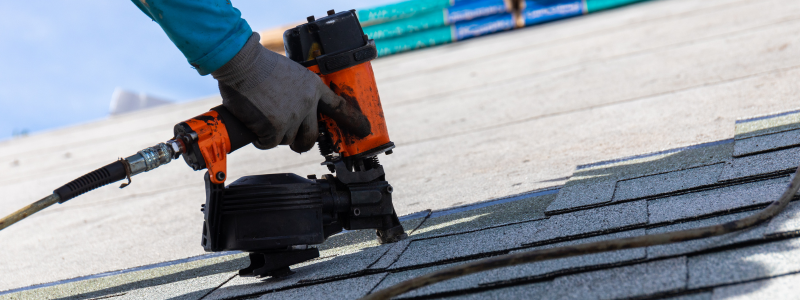
Why Choose B&M Roofing For Roof Replacement?
Roofing replacement projects can be quite a financial undertaking. That’s why it’s essential to hire a roofing specialist with proven experience. The experts at B&M Roofing of Colorado are equipped to help you with any project you throw at them! To receive a free estimate for your project, please get in touch with us by filling out this form or calling 303.443.5843.
How to Choose a Roof for your Home
When it’s time to get a new roof, many homeowners wonder which roofing type is ideal for their home. Many consumers explore many roofing types rather than merely replacing their existing roofing systems. While many considerations weigh into the decision, including covenants and personal esthetic preferences, each type of roofing has its own advantages. Don’t know how to choose a roof for your home? Here are some ideas…
Types of Roofing Materials
If you’re wondering how to choose a roof for your home, we’ve included a list of different types of roofs to consider:
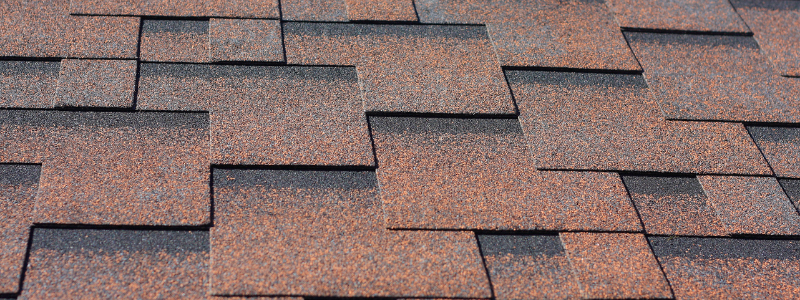
Asphalt Roofing
By far the most popular choice for roofing material, asphalt shingles are available in many colors to suit many homeowners’ tastes. We’ve installed our fair share of asphalt shingles and there are a couple of reasons for this:
- They are the most common, with over 75% of American roofs having them.
- They are the least expensive, costing homeowners about $50-$100 per square.
- They are one of the easiest to install, on just about any architectural style.
- They are one of the most affordable of all roofing materials and since they’re easily replaceable, this type of roofing style can cut down your repair costs.
- Asphalt shingles can usually last more than 30 years, depending on the weight of the shingle. These shingles are very fire resistant, as well.
- They can come in a variety of styles, making it easy to select shingles that will complement the style of your home.
However, you might want to consider the downsides to having asphalt shingles as well:
- They have a low R-value (insulation value): Being a thin material, their resistance to heat (and cool) flow is very low.
- They have a shorter lifespan: Compared to other roofing shingles, asphalt shingles don’t last long, lasting from only 15 to 30 years.
- They are not eco-friendly: They have the least-green roofing option to have on your roof and are not recyclable.
Metal Roofing
A more durable solution than traditional shingles, metal roofing systems also offer more leeway for architects’ designs to flourish, making it a favorite among high-end builders, though are typically much more expensive than other options. Lightweight and virtually fireproof, metal roofs withstand extreme weather well.
Homeowners can reasonably expect to get 50-60 years of service life from a metal roof, though that means you may be investing in a roofing system that will be around a lot longer than you’re in the house.
Metal roofs have a very high life expectancy. They’re weather-resistant, and offer especially good protection from high winds and snow. They are also fire-resistant, earning a Class A fire rating, which means it’s the most resistant.
While metal may seem like an odd roof choice, its range of styles and colors make it an excellent option for giving a modern update to older houses and buildings.
They are also remarkably low maintenance and generally come with a 20- to 40-year warranty. Even though the initial costs of a metal roof will be more than traditional materials, the minimal maintenance and low replacement costs will help save money in the long run.
Wood Shakes/Shingles
Many homeowners prefer the more natural look of cedar shakes and shingles for their roof. While more expensive than traditional asphalt shingles, you can expect them to last 30-40 years if maintained well. Cedar shakes and shingles are more resistant to extreme weather and more energy-efficient than asphalt options but are also more costly.
Wood shingles are small, light, and severed on both sides. Wood shakes are generally thicker and are hand-split. The most common wood shingles are cedar, which are longer-lasting and more fire-resistant. Fire-retardant coatings are typical with wood shingles. Take into consideration wood shingles require a steeper roof to get rid of moisture.
Wood shingles are beneficial for the following reasons:
- Natural Beauty – The character of wood shingles blends nicely with the landscape and other surroundings. Its natural color and look enhance your home’s overall curb appeal and over time, the cedar will change to a more old-fashioned, silver color.
- Lightweight – Second to asphalt shingles, wood (cedar) shingles are one of the most lightweight roofing materials, making them easier to repair.
- Insulation – Cedarwood is a natural thermal insulator, keeping your house cool during the summer and lowering the heating bill in the winter.
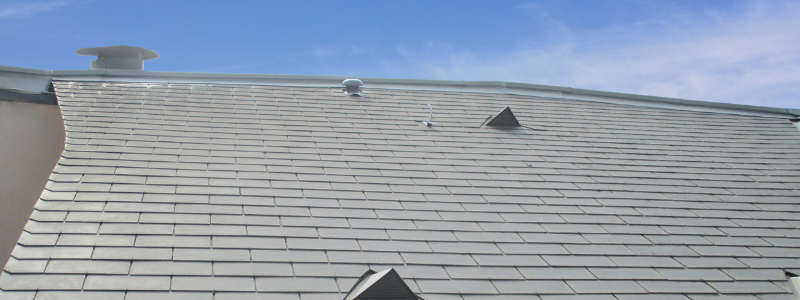 Tile and Slate
Tile and Slate
Homeowners who demand high style often choose tile or slate roofing systems. Concrete or clay tiles are available in numerous styles, from classic Tuscan tiling to fire-resistant concrete replicas of shake roofing.
While many tile and slate roofing systems are engineered to last up to 50 years and are highly resistant to Colorado weather, the roofing underlayment may need to be replaced every 20 years, requiring maintenance many homeowners don’t foresee. Also, because of the weight of these roofing systems, many homes must be structurally reinforced to accommodate them.
Clay Tiles
Clay tiles are all-natural and are fired in a kiln. They are generally one of the most expensive and heaviest of roofing materials. Clay tiles will last a long time, however, as they are environmentally friendly and are resistant to both freezing and hot temperatures, as well as the sun’s harmful UV rays.
However, they are more vulnerable to cracking in Colorado’s extremely low temperatures. There are some benefits, though, like:
- Insulation – Since hot and cold temperatures don’t affect clay tiles as much as other roofing materials, clay is a natural insulator, keeping the energy bill low.
- Low-maintenance – Clay tiles don’t absorb water, mold, or mildew very well, making them basically maintenance-free.
- Color – Clay tiles don’t lose their color much since they are a natural roofing material.
Slate Tiles
Slate tiles are natural, shingle-like, flat sheets of rock. Slate tiles can also be very pricey and heavy for your roof, but the stone look provides plenty of curb appeal to your home. Because of their weight, slate tiles do require extra roof support and framing.
This roofing material requires professional installation, as walking on these tiles can be difficult and result in breaking the stone slates.
In Colorado, these are the most common roofing options we’ve seen in our experience. We can also assist you in how to choose a roof for your home and what it consists of.
If you’re still wondering how to choose a roof for your home, our roofing experts can talk with you about your ideas, your budget, and your needs.
Winter Roof Problems
Snow can really add a sense of beauty and marvel to any home or commercial property. Winter has a sense of calm, comfort, and relaxation to it – however, when things start to get cold and wet, those feelings quickly disappear. To enjoy winter, it’s best to be prepared for what it can do to your roof. The secret to enduring the winter is if your roof can do the same. Roof damage is not just a hail storm or spring season-exclusive occurrence.
Winter is probably the most challenging season for your roof, even more so than the storms Colorado sees in the spring and summer.
There are many different winter roof problems your home or business could face and it is important to be prepared and ready for anything that might happen!
Before the first snowstorm comes, it is a good idea to inspect your roof and analyze if there is any existing damage. If you can catch a problem and address it early on, you are more likely to prevent a bigger issue from happening, which could ultimately save you a lot of money. If you have problems like any of the ones below, it’s not too late to have your roof looked at and repaired. After all, that’s the great thing about Colorado is that the sun still shines, giving us extra time to work on roofs.
Here’s what to look for during the winter:
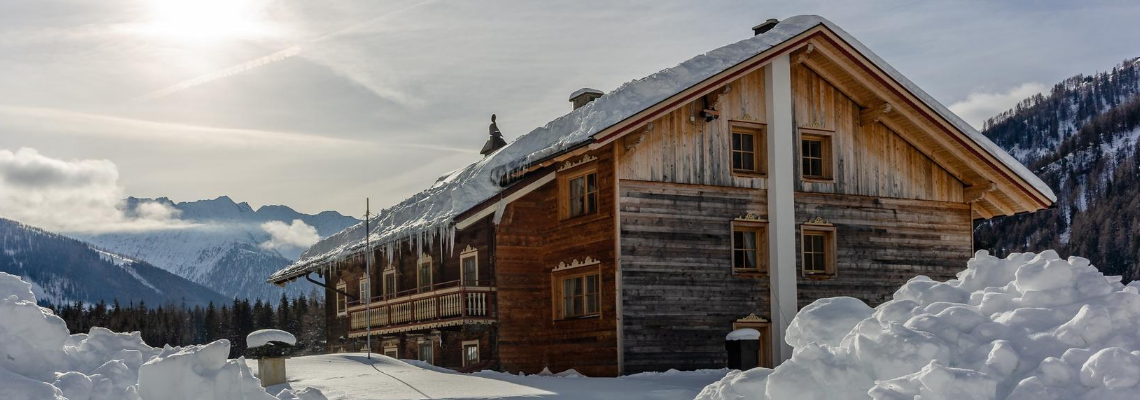
Typical Winter Roof Problems
If your roof appears to be in tip-top condition, you still want to keep an eye out for the following issues to arrive over the course of the winter season:
Ice dams
Icicles may look festive and decorative during the winter months, but they usually spell T-R-O-U-B-L-E for your roof and property. Ice dams are layers of ice that form at the edge of the roof which prevents melting snow from being able to properly drain off of the roof. The excessive buildup of melted snow then has nowhere to go and could end up in a home’s interior causing lots of damage, as well as damage to the roof.
Ice dams usually occur from inadequate ventilation or insulation in a home’s attic. If you discover your roof has ice dams, you will want to call a professional to come out and help you remove them. After the ice dams are removed and the issue is solved, it is important to constantly check your roof for signs of weathering to prevent further damage
Condensation in Attic
A warm attic with a cold roof over it is the perfect place for condensation to occur which can lead to mildew, mold, roof failure, and structural damage to your home. Poor ventilation is usually the main culprit to attic condensation, which is a complex issue that requires professional attention. If you notice that your attic has condensation, you will want to contact a professional who can help remedy the situation and ensure it does not happen again.
Adding things like roof vents and insulation will help prevent condensation from happening. This in turn will help prevent other winter roof problems like ice dams, leaks, freezing gutters, etc. The best time to install these roof accessories is during the early fall before the snow hits.
However, if you’re having problems with your roof during the winter and installing these items is the best option, we’re happy to install them in the winter months, too. Roof vents and insulation can be installed on both residential and commercial properties.
Flashing Leaks
Flashing is a section of sheet metal that protects the joints in a roof in order to prevent water damage. The locations of flashing vary depending on the type of roof, however flashing is most commonly used around a chimney, skylight, or dormer windows where leaking is likely to happen.
If you notice leaking around these areas, it means that the flashing could be damaged or weathered and it is time to call a professional roofing inspector. We recommend having a roofing inspector examine the roof flashing biannually to prevent larger issues from happening.
Flashing is much more affordable to fix when you catch it early on. Once the water has leaked through and caused damage, there are greater and more expensive issues that can arise.
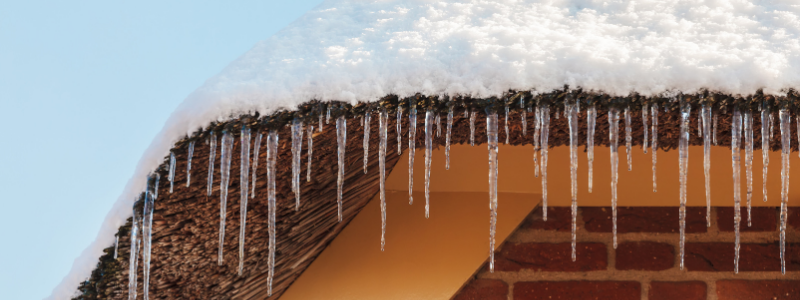
Freezing Gutters
Gutters freezing over is another typical winter roof problem. It usually occurs with ice dams, as they go hand-in-hand, but not always. Sometimes, especially in Colorado where we’ll experience a quick snowstorm and then the sun is right back out and shining the next day, the water from the roof drains from the roof into the gutters. Before the gutters are able to properly drain all of the water, the temperature drops, freezing the remaining water in the gutters.
This is usually because of leaves that are clogging up the drainage or something similar.
The next day when the temperature rises again, the water starts to leak into the windows, walls, and siding, instead of where it is intended to flow. You can prevent this from happening by making sure your gutters are cleared of any debris, but you can also drill a few holes in the gutter to help allow for faster draining. Typically, if you can solve your ice dams problems, you can solve the problem of your freezing gutters, too. Gutter guards are also a great idea to prevent the gutters from clogging up during the fall and winter months.
B&M Winter Roof Repair
Experiencing any of these winter roof problems? It’s not too late to get any repairs or even a roof replacement done – even after the snow has started falling. We have some temporary fixes until we’re able to help out. Don’t forget that we offer free estimates and emergency roof repair!
Stay ahead of the game this season and make sure your roof is ready to take on another Colorado winter.
Buying A House With A 20-Year-Old Roof
A roof is a home’s most important facet. Without a roof – or, without a good roof – everything in that home is susceptible to rain, snow, intense wind, strong heat, UV rays, and so much more. But, with a roof – a good, new one, in particular – your home is completely protected, ensuring that you and your loved ones are safe and that everything you own is completely protected.
Because of this, when searching for a new home, it is so important that you pay close attention to the age and wear of the roof of each house that you look at.
Buying a house with a 20-year-old roof means that, in the near future, you may be facing roof repairs or a roof replacement.
Inspect The Roof Before Purchasing The House
Just about every house that you find for sale will have some wear and tear. But, there are some houses that have older roofs – twenty years old, for instance – and these roofs have seen a lot more wear and tear than the roofs on other houses. Making sure that the roof of your new home is in decent shape, while also determining whether repairs are necessary for the near future, is extremely important. To accomplish both tasks in as little time as possible, having the roof inspected before you purchase the house is the best choice.
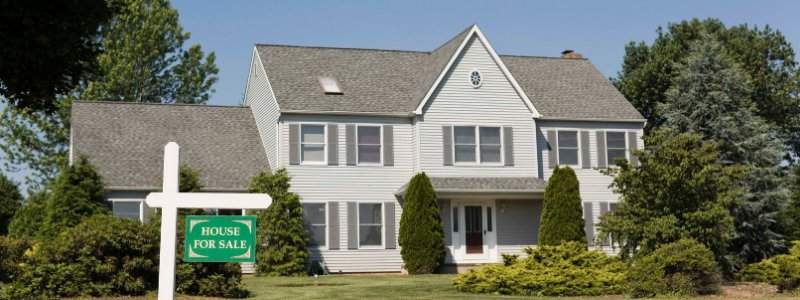
Your Budget Should Account for Roof Repairs
Even if you feel confident in the house that you’ve chosen to buy, if the roof is very old, then an inspection is a necessity. By purchasing the house, without having the roof inspected, it’s likely that a series of unforeseen issues may arise, most of which will be due to the roof’s age. But, if you have the roof inspected before you purchase the house, you can determine the condition of that roof, whether repairs are necessary and, if so, what those repairs are and when they should take place.
By doing an inspection before purchase, you can add into account the cost of roof repairs when you make an offer on the house.
A professional roof inspection consists of inspecting the roof’s exterior and, then, the roof’s interior. The roof exterior inspection consists of going onto the roof and examining the condition of the roof shingles, flashing, and chimney. The roof interior inspection consists of going into the attic and checking the insulation and ventilation, while also checking for leaks and mold. Right after the inspection is complete, you will learn the condition of the roof, any issues that are present, and what needs to be done to fix those particular issues.
What Should You Look For In An Old Roof And When Should You Walk Away?
As you look for your new home, there are a few attributes of each house’s roof that you must look for and take note of. Each one of these attributes will greatly affect the quality and condition of the roof, and those will, in turn, affect your experience living in your new home. By paying attention to these attributes, you will be able to know when to purchase a house and when you should walk away.
Every roof will be a little different. But, regardless of those general differences, there are a few attributes to look for in every roof that you check. These attributes will affect the quality and condition of the roof, as well as your experience in that house, tremendously.
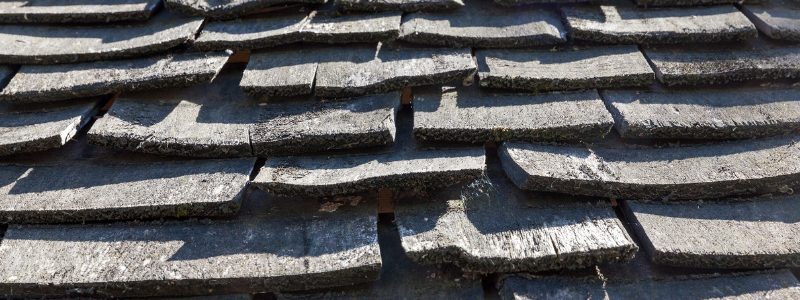
Worn or Missing Shingles
No matter what the house looks like, if you notice that there are missing shingles along the roof, large spaces where moss is growing over the shingles, sagging, or stains along with the ceiling and interior walls, you should walk away.
Each one of those problems can be dealt with. But, more often than not, the cost of repairing those problems is significant and, in the end, not worth the money, when buying a house with a 20-year-old roof.
Depending on the significance of those problems, you may end up having to replace the roof in its entirety, before you’re even able to enjoy the comfort of the home.
Your Homeowners Insurance Policy
Even though home insurance will cover – depending on the policy – roof repairs and replacements, there are a lot of home insurance policies that won’t cover roofs over twenty years old. Most of these policies work in one of two ways; they either won’t write a new policy for a roof that is over twenty years old or, for you to keep your old policy, they require the twenty-year-old roof to be replaced.
The attributes mentioned earlier are what to look for so that you know when to walk away. But, there are a few attributes to look for that indicate the roof you are looking at, even though it is old, remains strong and sturdy. These attributes include things like all of the shingles being present, the roof being perfectly even, clean and sturdy gutters; among various other things.
If you notice these attributes, then that’s a great sign, as it means the roof has been well-taken care of and should last for a while. But, that doesn’t necessarily mean repairs won’t be necessary, either now or in the relatively near future.
The Lifespan Of A Typical Residential Roof
A typical residential roof is meant to last for a specific period of time. But, this specific period of time varies from roof-to-roof, depending on the materials that the residential roof is made of. Being aware of the lifespan that certain roofs offer makes it easy to determine when your new house’s roof – or any roof, for that matter – will need to be replaced.
Every residential roof is meant to last for a certain amount of time. The exact amount of time that a particular residential roof is meant to last for depends entirely on the materials it is made of. Because of this, there are some roofs that can easily last for thirty years, and some that will fall apart long before that.
When buying a house with a 20-year-old roof, take into consideration what materials make up the roof of your potential new home.
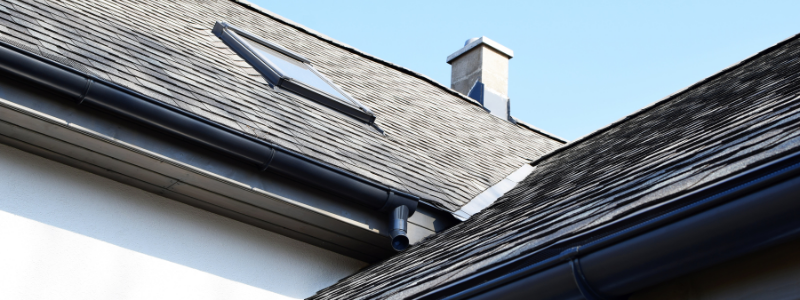
Asphalt Shingle Roofs
Most residential roofs make use of asphalt shingles. The reasons for this are quite simple: asphalt shingles are very affordable, and they often come with good warranties. More often than not, an asphalt shingle residential roof is meant to last for fifteen-to-thirty years. But architectural shingles, which are, essentially, enhanced asphalt shingles, can last for twenty-five-to-thirty years.
Other Material Roofs
Some of the more long-lasting materials are tile, slate, and copper. Roofs that make use of those materials can easily last for up to fifty years. Many other metal materials can last for fifty years, or a lot longer, depending on their overall quality.
If it’s asphalt shingles, you should expect a complete roof replacement. If it’s slate, metal, or other materials, you may have some extra time before a replacement is needed, but repairs may still be necessary.
B&M Roof Inspections
Regardless of the material that your residential roof is made of, though, B&M Roofing is here to help. By contacting us today, you can organize an inspection. Even before buying a house with a 20-year-old roof.
During this inspection, we will consider any flaws that your new home’s roof possesses, then we will tell you the repairs that are necessary, and perform those repairs. That way, no matter what it’s made of or how old it is, your roof will be in tip-top shape.
When To Get A Roof Inspection
The importance of your home’s roof cannot be overstated. A sturdy and strong roof is your home’s first defense against the elements. The key to a healthy roof is to know when to get a roof inspection.
To ensure that your roof is as sturdy and strong as it can be, having your roof inspected on a regular basis is our best advice. By having your roof inspected regularly, you will learn if your roof has any problems, and then you will be able to fix those problems, ensuring that your home remains protected from the elements.
What Is A Roof Inspection?
A roof inspection consists of two separate inspections – a thorough inspection of your exterior roof surface and a thorough inspection of your interior roof surface. By inspecting those two elements of your roof, a roof inspector is able to determine the current quality of your roof, while also pinpointing any problems that must be dealt with.
A roof inspection is, just as the name implies, an inspection of your roof. But a proper roof inspection is more than just a quick glance at your roof – a proper roof inspection consists of inspecting the exterior of your roof and the interior of your roof. By performing those two inspections, you are able to determine the current state of your roof, while also pinpointing any problems that must be dealt with.
Exterior Roof Inspection
An exterior roof inspection consists of inspecting the roof’s surface and basic structure. It also includes inspecting the perimeter of the property, including siding, gutters, air conditioning units, and more.
To perform an exterior roof inspection you must go onto the roof and examine things like:
- Shingles
- Flashing
- Gutters,
- Roof planes
That way, you can see if there are any broken shingles, cracks, leakages, damaged gutters, or ice dams.
Interior Roof Inspection
Right after the exterior roof inspection, you must perform an interior roof inspection.
To do this, you will need to go into your home’s attic and examine the insulation, ventilation system, and current state of the ceiling. Doing so allows you to make sure those facets of your roof are in tip-top shape, ensuring that things like mold growth or decayed roofing are present.
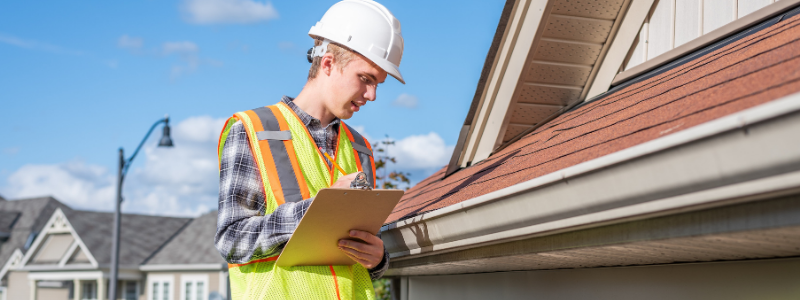
Why Are Roof Inspections Important?
A roof, for it to remain capable of protecting your home from the elements, must be in tip-top shape. It’s the first defense of your home, loved ones, and your belongings. For your roof to be in tip-top shape, it must not have any significant problems that can lead to the degradation of the roof and its inability to protect the interior of your home. To ensure that your roof does not have those problems and that if it does they are dealt with as soon as possible, regular roof inspections are of the utmost importance.
Colorado Weather Can Be Harsh
Everyone who lives in Colorado knows that Colorado is one of the most beautiful states in the country. Everyone who lives in Colorado also knows that Colorado is no stranger to bouts of exceptionally intense weather. All of the rain, wind, snow, and ice that Colorado experiences can have a significant effect on the quality and durability of your roof.
To ensure that Colorado’s elements do not affect your roof too much and that whatever problems they cause are dealt with as soon as possible, your roof must be inspected. A roof inspection will allow you to understand the current state of your roof, and whether or not there are any problems that must be dealt with. By knowing the current state of your roof, and knowing whether there are any problems to take care of, you are able to keep your roof in tip-top shape.
Many of the more significant roof problems reveal themselves slowly.
Prevent Other Roof Problems
During the Winter season, for example, it isn’t uncommon for ice dams to form on your roof. When an ice dam has formed, the water on your roof is unable to fall away, forcing it to leak into your home.
This may not be noticed, at first, but eventually, this water will build up and cause significant damage to:
- Roof
- Siding
- Ceilings
- Attic
- Walls
Since these problems reveal themselves slowly, it is important to have your roof inspected regularly, even if there doesn’t appear to be any problems. The problems that may be present will likely only get worse, and it’s considerably cheaper to remove an ice dam and replace some rotten shingles than it is to replace your entire roof, the ceilings in your attic, and various walls in your home.
When Should You Get A Roof Inspection?
According to The National Roofing Contractors Association, you should have your roof inspected during both fall and spring, as well as after any significant weather event. By having your roof inspected during those seasons, as well as after those events, you are able to notice any significant damages when they occur, allowing you to deal with them promptly.
The National Roofing Contractors Association recommends having your roof inspected at least twice a year; during fall and spring. Those two seasons, in particular, are the safest for both roof inspections and roof repairs. Inspecting your roof during the winter, especially in Colorado, may be dangerous.
Along with that, The National Roofing Contractors Association also recommends having your roof inspected after any significant weather event. A snowstorm, for example, can cause plenty of damage to your roof, so it’s a good idea to get your roof inspected right after the storm has passed.
A roof inspection for both Fall and Spring – two roof inspections annually – allows your roof to be inspected safely and thoroughly. Any damage that’s found on your roof can then be dealt with, during those seasons. Every time a significant weather event takes place, it’s a good idea to have your roof inspected. That way, you are able to check the state of your roof and take care of any problems that your roof may be an experience
Even though you can inspect your roof on your own, it’s almost always a good idea to hire a professional. A professional roof inspector knows how to traverse roofs of all sorts safely, and they also know how to inspect each and every facet of your roof. Because of this, when a professional roof inspector is finished inspecting your roof, they will know exactly what’s wrong – and what’s right, for that matter – with your roof. But, if you inspect your roof on your own, without any prior knowledge or experience, it’s likely that you may miss certain facets of your roof that need to be examined more closely and thoroughly.
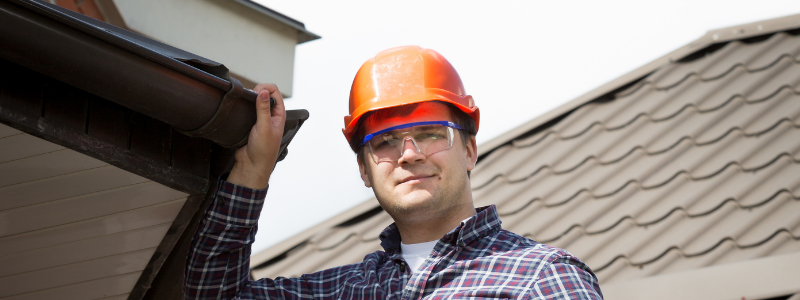
- The National Roofing Contractors Association recommends having your roof inspected one during Fall and once during Spring
- The National Roofing Contractors Association also recommends having your roof inspected after any significant weather event
- Fall and Spring are the safest and easiest seasons to have your roof inspected, especially in Colorado, due to the comparatively mild weather and safer weather conditions
- Hiring a professional roof inspector is almost always a good idea,
- A professional roof inspector knows how to traverse your roof in a safe manner
- A professional roof inspector will know how to examine every facet of your roof closely and thoroughly, ensuring that no problems or potential problems are missed
- B&M Roofing offers roof inspection services, you can get in touch with us today to get an inspector and a free estimate for any repairs or replacements that may be necessary
B&M Roofing offers roof inspection services. By getting in touch with us using this form, we will come to your home, inspect your roof, and then give you our estimate regarding any repairs or replacements that are necessary!
